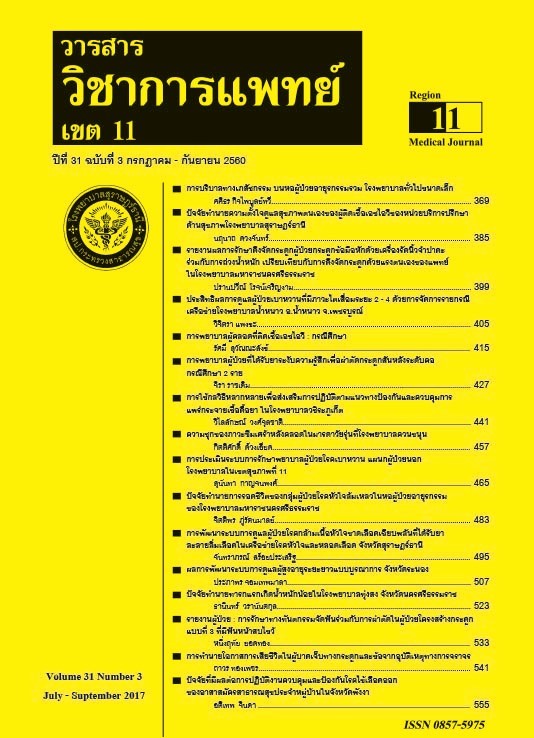Predicting Mortality of Orthopedic Trauma in Road Traffic Injury
Keywords:
Orthopedic trauma, Machine learning, MortalityAbstract
The accident that occur on the road as a problem to severe and increase in every years. Of the studies about road accident have found that mostly are caused by humans. So that to operate on a diverse group of patients, and many of these patients have concomitant medical problems. This research was conducted to categorize the mortality of orthopedic trauma by machine learning. To help in decision-making and reducing the errors due to discrimination skill in the treatment of orthopedic trauma of medical personnel to cope and manage to road traffic injured. The data source was used to learn from Suratthani hospital, Ministry of Public Health (MOPH. The interested results are divided into four model by risk of fatality, logistic regression, Decision tree or Recursive Partitioning, Random Forest, and Neural network. The R program shows results of the tests and the accuracy of the model with the set of data yield a high accuracy performance.
References
Barnes, S., Hamrock, E., Toerper, M., Siddiqui, S. and Levin, S. 2016. Real-time prediction of inpatient length of stay for discharge prioritization. Journal of the American Medical Informatics Association. 23, 2–10.
Chisholm, D., Naci, H., Hyder, A.A., Tran, N.T. and Peden, M. 2012. Cost effectiveness of strategies to combat road traffic injuries in sub-Saharan Africa and South East Asia: mathematical modeling study. British Medical Journal.344:e608 doi: 10.1136/bmj.e608.
Deprez, P., Shevchenko, P.V. and Wuthrich.,V.M. 2017. Machine Learning Techniques for Mortality Modeling. European Actuarial Journal.7(15), 193-230.
Department of Highways and Faculty of Engineering Prince of Songkla University. 2007. Final report of the study of traffic accident costs in Thailand. Faculty of Engineering Prince of Songkla University Available: http://siteresources.worldbank.org/INTTHAILAND/Resources/333200-1177475763598/Sep07-traffic_accident-full-report.pdf [November 14, 2011].
Gardner, R., Smith, G.A., Chany, A.M., Fernandez.S.A. and McKenzie, L.B. 2015 Factors associated with hospital length of stay and hospital charges of motor vehicle crash related hospitalizations among children in the United States. Archives of Pediatrics Adolescent Medicine. 161(9), 889–895
Kim, K.S., Kim, S.D. and Lee, S.H. 2012. Trend of mortality rate and injury burden of transport accidents, suicides, and falls. Journal of Preventive Medicine and Public Health. 45(1), 8-13.
Koedklai, S., Dumnakeaw, K. and Kumwongsa, A. 2009. Epidemiology of injuries and deaths caused by road traffic accidents in Thailand. Journal of Health Systems Research. 3(4), 598-605. (in Thai)
Kononen, D.W., Flannagan, C.A.C. and Wang, S.C. 2011. Identification and validation of a logistic regression model for predicting serious injuries associated with motor vehicle crashes. Accident Analysis and Prevention. 43, 112-22.
Liu, N.T. and Salinas, J. 2017. Machine Learning for Predicting Outcomes in Trauma. The National Center for Biotechnology Information Journal. 5,11-17.
Reddy, G.M.M., Negandhi, H., Singh, D. and Singh, A. 2009. Extent and determinants of cost of road traffic injuries in an Indian city. Indian Journal Medical Sciences. 63(12), 549-556.
Sriwattanapongse, W., Prasitwattanaseree, S., Khanabsakdi, S. and Wongtra-ngan, S. 2013. Mortality rate model due to transportation accidents in Thailand. Silpakorn University Science and Technology Journal. 7, 9-18.
Suriyawongpaisal, P. and Aekplakorn, W. 2003. Textbooks of Epidemiology and Traffic Accidents. Bangkok: Holistic Publising. (in Thai)
Tanaboriboon, Y. and Satiennam, T. 2005. Traffic accidents in Thailand. Internationational Association of Traffic and Safety Sciences. 29, 88-100.
Thairoads Foundation and Thailand Accident Research Center (TARC). 2011. Report Road Accidents in Thailand 2010. Bangkok: National Health Foundation. (in Thai).
United Nations .2017. Strategic Approaches for Injury Prevention and Control in the South-East Asia Region. India. United Nations.
Westin, L.K. 2001. Receiver Operating Characteristic (ROC) Analysis : Evaluating discriminance effects among decision support systems.2012. Umea, Sweden: Department of Computer Science, Umea University. Available: http://www.cs.umu.se/research/reports/2001/018/part l.pdf.
William,C. 2005. The relevance of an evolutionary model to historical linguistics. In O. Nedergård Thomsen (ed.), Competing models of linguistic change: Evolution and beyond. Amsterdam: John Benjamins. 91–132.
World Health Organization. 2017. The Global Burden of Disease: 2015 Update. Geneva: World Health Organization.
Yang, L., Lam, L.T., Liu, Y., Geng, W.K. and Liu, D.C. 2005. Epidemiological profile of mortality due to injuries in three cities in the Guangxi province, China. Accident Analysis and Prevention. 37, 137-141.






